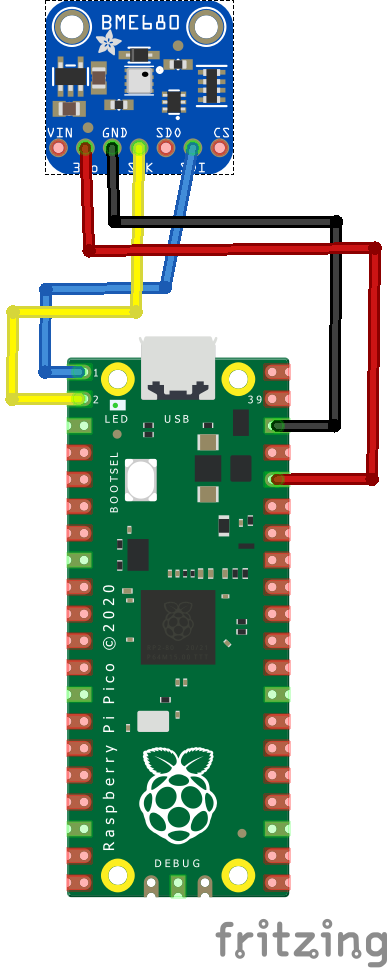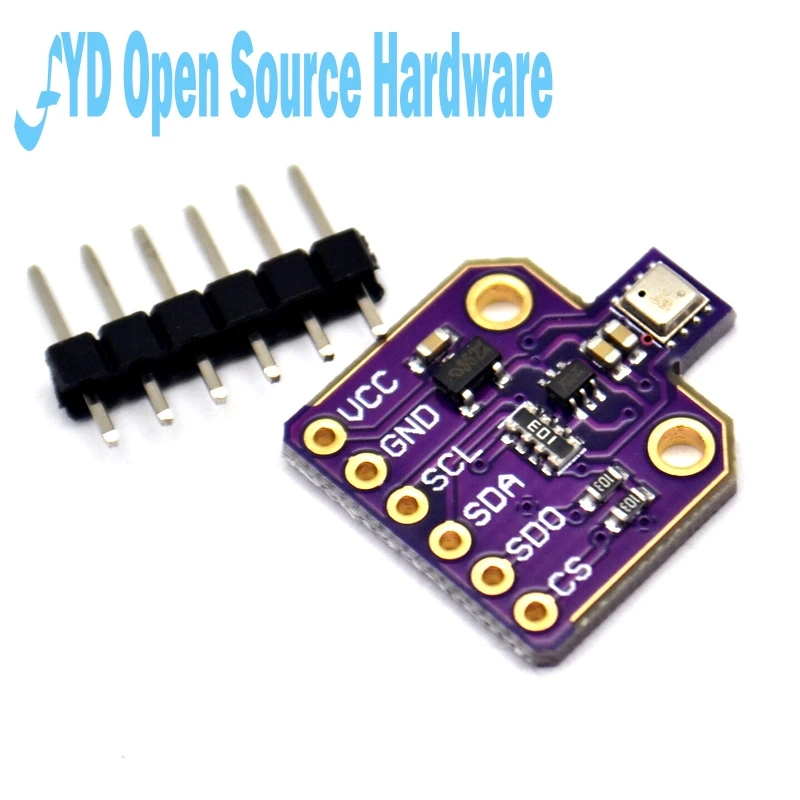In this article we connect a BME680 gas sensor to a Raspberry Pi Pico running Circuitpython
Sensor Information
The BME680 is a gas sensor that integrates high-linearity and high-accuracy gas, pressure, humidity and temperature sensors. It is especially developed for mobile applications and wearables where size and low power consumption are critical requirements.
The BME680 guarantees – depending on the specific operating mode – optimized consumption, long-term stability and high EMC robustness.
In order to measure air quality for personal wellbeing the gas sensor within the BME680 can detect a broad range of gases such as volatile organic compounds (VOC).
| Parameter | Technical data |
|---|---|
| Package dimensions | 8-Pin LGA with metal 3.0 x 3.0 x 0.93 mm³ |
| Operation range (full accuracy) | Pressure: 300…1100 hPa Humidity 0…100% Temperature: -40…85°C |
| Supply voltage VDDIO Supply voltage VDD |
1.2 … 3.6 V 1.71 … 3.6 V |
| Interface | I²C and SPI |
| Average current consumption (1Hz data refresh rate)) Average current consumption in sleep mode |
2.1 µA at 1 Hz humidity and temperature 3.1 µA at 1 Hz pressure and temperature 3.7 µA at 1 Hz humidity, pressure and temperature 0.09‒12 mA for p/h/T/gas depending on operation mode |
| Gas sensor Response time (τ 33-63%) Sensor-to-sensor deviation Power consumption Output data processing |
< 1 s (for new sensors) +/- 15% +/- 15 < 0.1 mA in ultra-low power mode direct output of IAQ: Index for Air Quality |
| Humidity sensor Response time (τ0-63%) Accuracy tolerance Hysteresis |
8 s ± 3 % relative humidity ≤ 1.5 % relative humidity |
| Pressure sensor RMS Noise Sensitivity Error Temperature coefficient offset |
0.12 Pa (equiv. to 1.7 cm) ± 0.25 % (equiv. to 1 m at 400 m height change) ±1.3 Pa/K (equiv. to ±10.9 cm at 1°C temperature change) |
Parts Required
A more expensive which can cost up to $11 to $14
| Name | Link |
| Pico | Raspberry Pi Pico Development Board |
| BME680 | BME680 Digital Temperature Humidity Pressure Sensor |
| Connecting cables | Aliexpress link |
Schematic/Connection
Black for GND
Red for V+
Blue for SDA
Yellow for SCL
So color coded for ease of use, this layout shows a connection to the module

rp2040 and bme680
Code Example
I used Thonny for development
The following is based on a library , I copied the adafruit_bme680.mpy library for this device to the lib folder on my Raspberry Pi Pico – https://circuitpython.org/libraries
This is the basic example which comes with the library
[codesyntax lang=”python”]
import time
import board
import adafruit_bme680
import busio
i2c = busio.I2C(scl=board.GP1, sda=board.GP0) # uses board.SCL and board.SDA
# To initialise using the default address:
bme680 = adafruit_bme680.Adafruit_BME680_I2C(i2c, 0x76)
# change this to match the location's pressure (hPa) at sea level
bme680.sea_level_pressure = 1013.25
# You will usually have to add an offset to account for the temperature of
# the sensor. This is usually around 5 degrees but varies by use. Use a
# separate temperature sensor to calibrate this one.
temperature_offset = -5
while True:
print("\nTemperature: %0.1f C" % (bme680.temperature + temperature_offset))
print("Gas: %d ohm" % bme680.gas)
print("Humidity: %0.1f %%" % bme680.relative_humidity)
print("Pressure: %0.3f hPa" % bme680.pressure)
print("Altitude = %0.2f meters" % bme680.altitude)
time.sleep(1)
[/codesyntax]
Output
Here is what I saw in Thonny REPL window
Temperature: 13.8 C
Gas: 57510 ohm
Humidity: 48.8 %
Pressure: 995.629 hPa
Altitude = 147.76 meters
Temperature: 13.8 C
Gas: 19884 ohm
Humidity: 48.9 %
Pressure: 995.628 hPa
Altitude = 147.76 meters
Links
https://www.bosch-sensortec.com/media/boschsensortec/downloads/datasheets/bst-bme680-ds001.pdf

